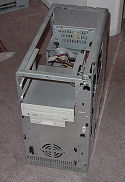|
|
|
Purcell and Elmslie, Architects Firm active :: 1907-1921
Minneapolis, Minnesota :: Chicago,
Illinois |
Ye Older Grindstones
3/19/2005
The first machine, an Aptiva Pentium I 100, to serve the pages that became known as Organica (1994-1996).
The second Organica server, an AST Pentium I 200, which really was a work horse (1996-2004).
The third Organica server, a Compaq Presario 5170 [die, die die, stupid BIOS on hard drive partition!] lasting all of six weeks (2004-2005)
The latest Organica server, which is also my workstation, another HP Compaq, not that I wanted another one, but it was what I could get my hands on (2005- ).Hasta Revista, Baby. Side door re-entry lengthy rambling at hand by way of a personal musing about Organica and my goals rather than any (or much) new P&E information, placed here mostly for the diehard Grindstone readers who like the backstage revue. Major energy shifts this past week within my own perspective, and I feel activated.
Organica costs about $70 a month to keep on the ether waves. When the old equipment breaks, as the DSL modem did last weekend ($80) or a computer dies ($500), that's additional scratch. Organica is an act of love on my part, so the money (or the thousands of hours of effort) has not mattered to me except when Pacbell would send a disconnect notice because the phone bill was two months past due, very much like the one from the Los Angeles Department of Water and Power [LADWP] iin hand at the moment of this writing. The continued existence of Organica has always rested on a wing and a prayer. And in six years of operation the web logs show approximately 60,000 unique visitors. The above computers have been the camels in the caravan.
Word comes that David Gebhard's 1950s dissertation has been revised by his surviving wife and is now in proofs at the publisher. Dixie Legler is said to be doing a P&E book that should be out in the near term. Happy news for P&E and their "readership." Pat Gebhard has most graciously credited Organica as a valued resource in her work. Recent additional communications with older friends of this site have made it clearer to me that many people share that view. Ironically, this all came about because the infrastructure that serves the pages came crashing down one weekend and I was slow to make repairs. I thought, who cares? No one will miss it for a few days. I was wrong.
In reviewing the last year of Grinds, there are few updates. Although my heart was up for it, as always, the inner mind was apparently in outer space because I find little of new substance appeared. As time went on several correspondents kindly inquired what was up with me, as nothing had been done since whenever. These e-missives would spurn my hope and guilt, and that caused a couple of mea culpa "I'm back" Grinds. However, those waves of promise came to naught.
Lay what part of that you can to Mars camping out for an unusual extended celestial period of six months in Taurus, my twelfth house of secret enemies and hidden obstacles, if you are conversant with the dial on that clock. The period started off with a "mini-stroke" with short term paralysis (though there seemed nothing small about it to me) and then meandered through a long period of uncertain employment, irregular paychecks, and a deeply unpleasant renege of a promised business partnership on a project I would have been very good at doing. I had been having severe migraines regularly due to work-related stress since the first of the year anyway, and the last straw of that situation was standing in a parking lot as my body turned to rubber. My consciousness darkened in a circle around me and the blackened edges curled inward, consuming my awareness exactly like a full solar eclipse does the horizon, if you've ever experienced one.
I watched, unable to speak or move without enormous effort, as everything disappeared: my books, my cats, my home, my hopes, my dreams, my wishes, all vanished into utter void. I was hyper alert to this happening, and the thought, given where I was wavering pseudo-upright in place, that I was being parked did not passed unnoticed. Everything came down to a tight ring of white light, an aura of painful brightness, and then the pressure reversed. My left hand curled up into a ball and stayed that way for two days. Hope, dreams, wishes, and my books rematerialized in sharper relief.
Now regular readers of my bleating here know I have lived from hand to mouth, sometimes missing, since before 9/11. Naturally, I have no health care. So I went to bed and waited for the numbness in my arm to turn to tingling stiffness and my hand to unfurl. Then I picked up the phone and quit my job as "Operations Director" of an architecture firm. The rent was due in three days and I had not dollar one. My roommate announced his departure. Some people get the Golden Path, and some the one made of iron. And, without further elaboration, things went from there onward to the present moment in something of a daze of days. Who could write?
Like Claude Bragdon, the Griffins, and others (I don't know what Purcell would say, strangely enough), I have a sense of omens. The effect is part and parcel of the fabric of mind called four dimensional consciousness. Everyone has the potential; you just have to pay attention to the pattern of the holism around you. Very recently, a photograph of George Elmslie that once belonged to Purcell and which hangs above my computer flew off the wall quite without any assistance from an earth tremor. The other portrait of WGP and everything else hanging in that cluster remained in place. I put GGE back up. The next morning, the same thing happened with my framed AIA award certificate. Ker-thunk. Omen. Amen. (I've always found it interesting that Christians seal every prayer by pronouncing the name of the highest ancient Egyptian god). Someone once said, more colorfully, that superstition is just advice not to urinate into the wind.
Something is up with P&E in my house. I chanced yesterday to see that a wonderful used bookstore in Studio City is closing after many years and I went inside to pay homage. Books were all half price. For $20 I walked out with volume 1 of FLLW's collected writings and Manson's FLLW to 1910: The First Golden Age. Sure, I've used these books, but never owned copies. Let's hope LADWP doesn't mind. I need to lose weight anyway, so I am happy with that use of my grocery money.
Someone asked me recently if I could have a wish granted for my work, what would it be. I said that a year to eighteen months of being able to work on my work would do the trick. The smartass then said, "Oh, you just want a grant." Whatever. That was the 80s, before Reagan made church mouse scholarship taxable. What I want is to get my P&E book done, which does not resemble the Gebhard or Legler books in any way. Read this from the first couple of pages of my Minnesota 1900 essay:
The creed advanced by Louis Sullivan conceived of architectural design in the biological metaphor of the natural world. In that sphere, of which humans were inextricably part, all experiences came into being through the actions, or functions, that were transmitted by the structural shapes, or forms, of material objects. All physical things conducted directly a momentum of activity, like copper wire carried electricity. One event arose from another in a cascade of interrelationship. This holistic mode of unfoldment was the fundamental order of existence, the way everything worked. Sullivan epitomized his view in the phrase form follows function. The organic architectural philosophy initiated by Louis Sullivan descended from his own practice principally through two lines. One of these paths encompassed the much-examined work of Frank Lloyd Wright (1867-1959), whose lengthy and metamorphic career has continued to attract a large public following. The other direct lineage from Sullivan was formed by the partnership of George Grant Elmslie and William Gray Purcell. Because their work is rarer and not as publicly identified, the labors of Purcell and Elmslie for the cause of organic architecture have been less celebrated than those of Wright. Nonetheless, their understanding and articulation of organic design was fully developed on the most profound and encompassing levels:
"These organic procedures exemplified the living relation which was practiced in exposition of democracy within our living world. Architecture as we saw it was called upon to express, in peace and mutual respect, that cooperation between the inanimate ‑ the material world, which we now know is never inanimate or "material" ‑ and the world of Man, together with his companions, the animals and the plants.... If these relations within a living democracy cannot be shown as the home and fountain of our mutual life in common with all living creations, then any further attempt to study and explain them becomes futile."
Purcell, in "WGP Review of [David S.] Gebhard Thesis, George Grant Elmslie Section Part IV" (version of draft dated 7 March 1956. William Gray Purcell Papers, Correspondents record group, David S. Gebhard files [C:124].
For Purcell and Elmslie, organic architecture was a matter of faith. Any assessment of their work must take into account the metaphysical motivations implicit in the work of these architects. Their spirituality, however, needs to be severed from the dogmatic connotations of religion. The key to the spiritual concept realized by the organic architects was a kind of gnostic perception, through which the continuities of past and future human life were identified contextually with the immediate circumstance. Inner recognition of need and response came first, and the external formulation of shape derived from those informing ideas. If done with spiritual conscience, organization of the mundane elements would intuitively endow the structure with the intangible yearnings out of which the design had first commenced. By the organic standard, this task was the vocation of the architect. Those devoted to this cause envisioned the result to be an important means of social progress, and thus came to be known in general parlance as progressive architects (a usage of the term distinct from, though obviously in character with, the contemporary political drive of the same name). Because this movement was born and centralized in the prairies of the American Midwestern states, these men and women have also come to be called Prairie architects.
There, in the entirety, is the seed thought of my P&E book. Imagine a few hundred pages of crystallized commentary based on the available documentation. That is the wish I made for the sake my well-heeled friend who just can't relate to driving a car more than two years old (thankfully, he doesn't read this). And as we all know, if wishes were BMWs, more people in southern California would have them than already do. And there are so many on the road, makes me wonder if I can get mine anytime soon...
It seems to me that between flying photographs and kind missives the pot is being stirred. We'll see, huh?




